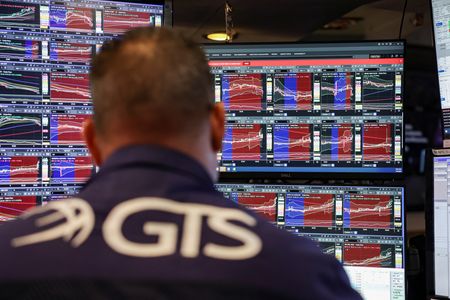By Medha Singh and Twesha Dikshit
(Reuters) -A bumper rally in European stocks appears to be slowing, putting Wall Street in the lead again after a lopsided U.S.-EU trade deal revived concerns about the economic outlook and the health of corporate earnings.
After a sharp outperformance by European stocks over Wall Street in March, the STOXX 600 stands almost neck and neck with the S&P 500, rising 8.3% on a year-to-date basis compared with an 8.6% gain for the latter.
After coming within 1.8% of its March all-time high, the pan-European index has remained largely unchanged since the trade deal was announced over the weekend.
The deal also slammed the brakes in the euro’s recent rally, putting it on track for its first monthly drop this year.
The 15% tariff on most goods from the EU is half the threatened rate, but still significantly higher than pre-2025 levels, with no precise agreement on which duties will apply to pharmaceuticals – a key European export.
“The impact of tariffs on exporters’ profits will show up rather quickly. If the EU’s economic outcome and corporate profits turn out to be worse than thought, the rally in EU stocks may stall or reverse,” said Janet Mui, head of market analysis at wealth manager RBC Brewin Dolphin.
Expectations around earnings growth for STOXX 600 companies have significantly improved after the trade deal, but the outlook has darkened for the rest of the year. Analysts estimate a 2.2% drop in fourth-quarter profits, compared with a 0.9% decline forecast on July 1, according to LSEG I/B/E/S data.
The deal should help Europe avoid a recession, but is unlikely to lift the region out of stagnation. The outcome falls between two tariff scenarios the ECB projected last month that implied 0.5% to 0.9% growth this year, well below the 1% forecast in an environment free of trade tensions.
Meanwhile, optimism about trade deals, an AI-driven lift for technology shares and the prospect of interest-rate cuts from the Federal Reserve have pushed U.S. stocks to all-time highs.
“If we have to think till the year end, we’re more positive on U.S. versus European stocks,” said Anthi Tsouvali, multi-asset strategist at UBS Wealth. “A lot of the good news has already been priced in (in) Europe.”
Cheap valuations, Germany’s big plans for spending on infrastructure and defense and a string of rate cuts from the European Central Bank boosted the appeal of European assets earlier this year.
But signs of a resilient Euro zone economy so far have investors betting that the ECB is close to wrapping up its rate-cutting cycle. Traders see just a 50% chance of another reduction by December and a small chance that rates will actually start rising towards the end of 2026.
European stocks also appear to have missed out on the big artificial intelligence wave U.S. stocks are surfing. AI-chip designer Nvidia this month became the first company to hit $4 trillion in market value.
German tech firm SAP is the most valuable European company, with a market value of $306.4 billion. Danish drugmaker Novo Nordisk, a market heavyweight, shed about 25% in stock value after issuing a profit warning on Tuesday.
“U.S. corporates continue to generate higher returns than their European peers and it’s an earnings momentum that we see beyond the tech champions. Europe still lags, with more anemic growth,” said Charles de Boissezon, global head of equity strategy, Societe Generale.
(Reporting by Medha Singh and Twesha Dikshit in Bengaluru; Writing by Sruthi Shankar; Editing by Amanda Cooper and Pooja Desai)







